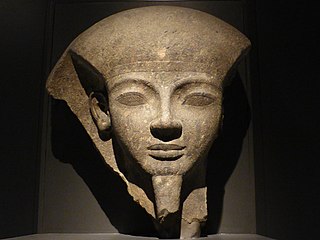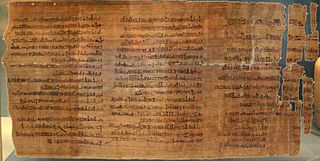
Neferkare Setepenre Ramesses IX was the eighth pharaoh of the Twentieth Dynasty of Egypt. He was the third longest serving king of this Dynasty after Ramesses III and Ramesses XI. He is now believed to have assumed the throne on I Akhet day 21 based on evidence presented by Jürgen von Beckerath in a 1984 GM article. According to Papyrus Turin 1932+1939, Ramesses IX enjoyed a reign of 18 years and 4 months and died in his 19th Year in the first month of Peret between day 17 and 27. His throne name, Neferkare Setepenre, means "Beautiful Is The Soul of Re, Chosen of Re." Ramesses IX is believed to be the son of Mentuherkhepeshef, a son of Ramesses III, since Mentuherkhopshef's wife, the lady Takhat bears the prominent title of King's Mother on the walls of tomb KV10, which she usurped and reused in the late 20th Dynasty; no other 20th Dynasty king is known to have had a mother with this name. Ramesses IX was, therefore, probably a grandson of Ramesses III.

Heqamaatre Setepenamun Ramesses IV was the third pharaoh of the Twentieth Dynasty of the New Kingdom of Ancient Egypt. He was the second son of Ramesses III and crown prince when his elder brother Amenherkhepshef died aged 15 in 1164 BC, when Ramesses was only 12 years old. His promotion to crown prince:
is suggested by his appearance in a scene of the festival of Min at the Ramesses III temple at Karnak, which may have been completed by Year 22 [of his father's reign].

Menmaatre Ramesses XI reigned from 1107 BC to 1078 BC or 1077 BC and was the tenth and final pharaoh of the Twentieth Dynasty of Egypt and as such, was the last king of the New Kingdom period. He ruled Egypt for at least 29 years although some Egyptologists think he could have ruled for as long as 30. The latter figure would be up to 2 years beyond this king's highest known date of Year 10 of the Whm Mswt era or Year 28 of his reign. One scholar, Ad Thijs, has suggested that Ramesses XI could even have reigned as long as 33 years.

The Valley of the Queens is a site in Egypt, where the wives of pharaohs were buried in ancient times. It was known then as Ta-Set-Neferu, meaning "the place of beauty". It was most famous for being the burial site of many wives of Pharaohs. Pharaohs themselves were buried in the Valley of the Kings.

Ramesses VI Nebmaatre-Meryamun was the fifth ruler of the Twentieth Dynasty of Egypt. He reigned for about eight years in the mid-to-late 12th century BC and was a son of Ramesses III and queen Iset Ta-Hemdjert. As a prince, he was known as Ramesses Amunherkhepeshef and held the titles of royal scribe and cavalry general. He was succeeded by his son, Ramesses VII Itamun, whom he had fathered with queen Nubkhesbed.

Usermaatre Setepenre Meryamun Ramesses VII was the sixth pharaoh of the 20th Dynasty of Ancient Egypt. He reigned from about 1136 to 1129 BC and was the son of Ramesses VI. Other dates for his reign are 1138–1131 BC. The Turin Accounting Papyrus 1907+1908 is dated to Year 7 III Shemu day 26 of his reign and has been reconstructed to show that 11 full years passed from Year 5 of Ramesses VI to Year 7 of his reign.

The Royal Cache, technically known as TT320, is an Ancient Egyptian tomb located next to Deir el-Bahri, in the Theban Necropolis, opposite the modern city of Luxor.

Tomb ANB is a sepulchre located in the west of the necropolis of Dra' Abu el-Naga', near Thebes, Egypt. It may well have been intended as the burial place of the 18th Dynasty Pharaoh Amenhotep I and his mother Ahmose-Nefertari.

The Valley of the Kings, also known as the Valley of the Gates of the Kings, is a valley in Egypt where, for a period of nearly 500 years from the 16th to 11th century BC, rock-cut tombs were excavated for the pharaohs and powerful nobles of the New Kingdom.
Sekhemre Shedtawy Sobekemsaf II was an Egyptian king who reigned during the Second Intermediate Period, when Egypt was fragmented and ruled by multiple kings. He was once thought to belong to the late Thirteenth Dynasty, but is today often placed as a king of the Seventeenth Dynasty of Egypt. His throne name, Sekhemre Shedtawy, means "Powerful is Re; Rescuer of the Two Lands." It is now believed by Egyptologists that Sobekemsaf II was the father of both Sekhemre-Wepmaat Intef and Nubkheperre Intef based on an inscription carved on a doorjamb discovered in the ruins of a 17th Dynasty temple at Gebel Antef in the early 1990s which was built under Nubkheperre Intef. The doorjamb mentions a king Sobekem[saf] as the father of Nubkheperre Intef/Antef VII--(Antef begotten of Sobekem...) He was in all likelihood the Prince Sobekemsaf who is attested as the son and designated successor of king Sobekemsaf I on Cairo Statue CG 386.

Paweraa was the Mayor of Western Thebes during a series of tomb robberies that occurred in the Valley of the Kings during the late New Kingdom of Ancient Egypt. In official transcripts of a Tomb Robbery report from Year 16 of Ramesses IX, Paweraa was accused by Paser, the Mayor of Eastern Thebes, of either being involved in the series of Tomb robberies or being negligent in his duties in protecting the royal tombs from incursions by marauding Libyan bands or conventional Egyptian tomb robbers. The vizier Khaemwaset ordered an investigation by a commission of which Paweraa himself was the head. The investigation was considered corrupt by the people of Deir el-Medina. In the ensuing trial seventeen workmen from near-by temples were convicted and executed. Paweraa, however, was never charged due to the lack of clear evidence of his guilt. He continued to serve in office while Paser, his accuser, vanished from history, and the robberies continued.
The period of ancient Egyptian history known as wehem mesut or, more commonly, Whm Mswt can be literally translated as Repetition of Births, but is usually referred to as the (Era of the) Renaissance.

The Abbott Papyrus serves as an important political document concerning the tomb robberies of the Twentieth Dynasty of Egypt during the New Kingdom. It also gives insight into the scandal between the two rivals Pawero and Paser of Thebes.
The Mayer Papyri are two ancient Egyptian documents from the Twentieth Dynasty that contain records of court proceedings.
The ancient Egyptian document PapyrusLeopold II, is part of the original court records dealing with the tomb robberies under Ramesses IX and dates to Year 16 of Ramesses IX. It contains the confessions of eight men who had broken into the tomb of Sobekemsaf II and a description of the reconstruction of the crime. It throws light on the practices followed at ancient Egyptian courts: eliciting confessions by beating with a double rod, smiting their feet and hands, reconstructing the crime on site, and imprisonment of suspects in the gatehouse of a temple. The document remains an important document for understanding the importance of burial and the afterlife in ancient Egypt as well as crime and punishment practices in Egypt during the 20th Dynasty.
Tyti was an ancient Egyptian queen of the 20th Dynasty. A wife and sister of Ramesses III and possibly the mother of Ramesses IV.

The Twentieth Dynasty of Egypt is the third and last dynasty of the Ancient Egyptian New Kingdom period, lasting from 1189 BC to 1077 BC. The 19th and 20th Dynasties furthermore together constitute an era known as the Ramesside period. This dynasty is generally considered to be the start of the decline of Ancient Egypt.
This page list topics related to ancient Egypt.
Khaemwaset or Khaemweset was a personal ancient Egyptian name popular during the New Kingdom. Some notable bearers were:
Papyrus Ambras is a papyrus which was formerly in the collection of Ambras Castle near Inssbruck, and is now a part of the collection of the Vienna Museum. The first to draw attention to it was the Egyptologist Heinrich Karl Brugsch, who published about it in 1876.










